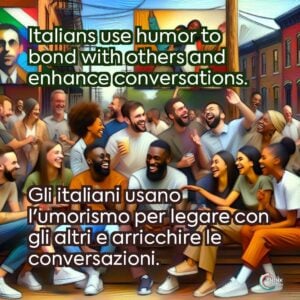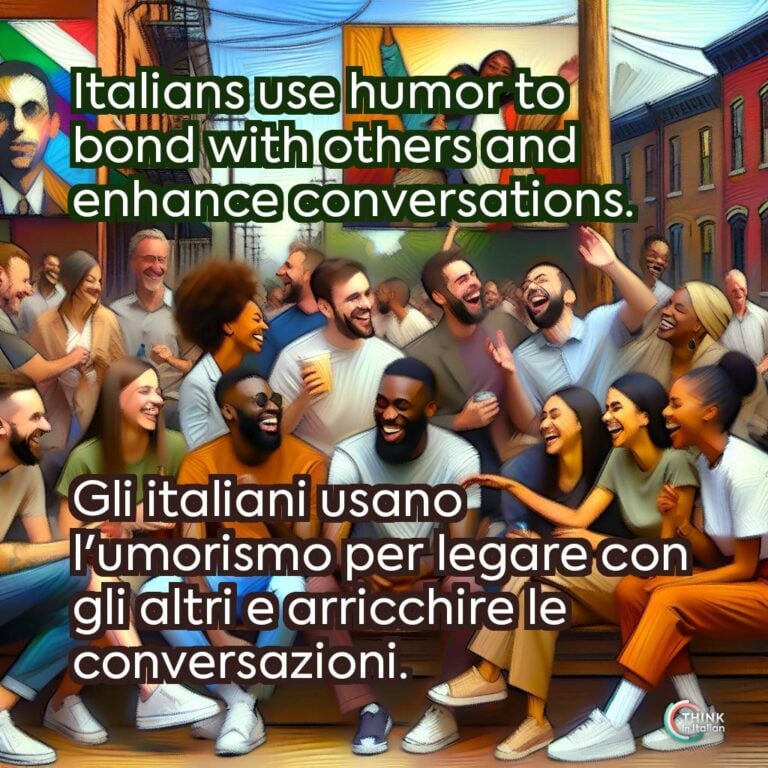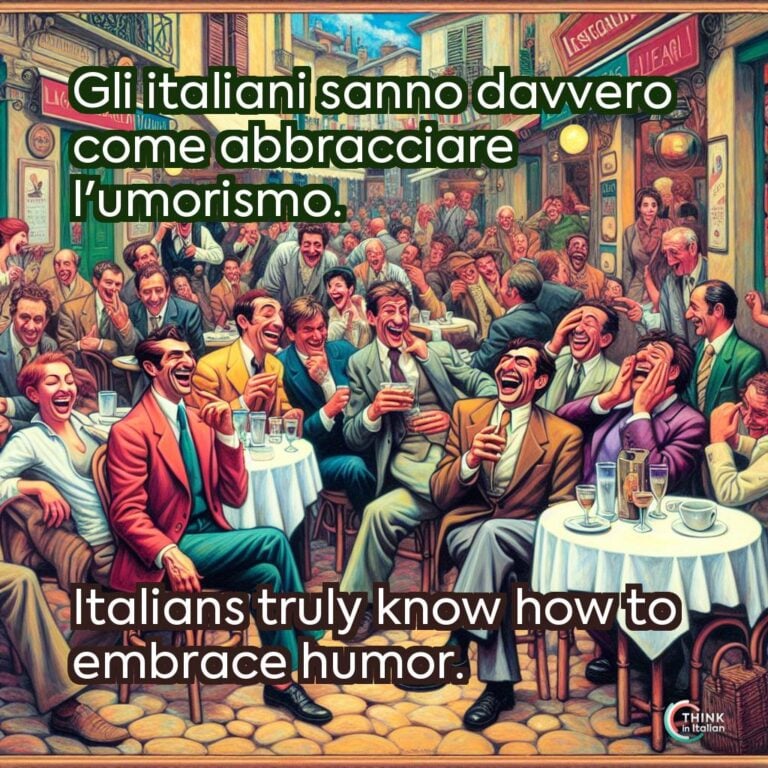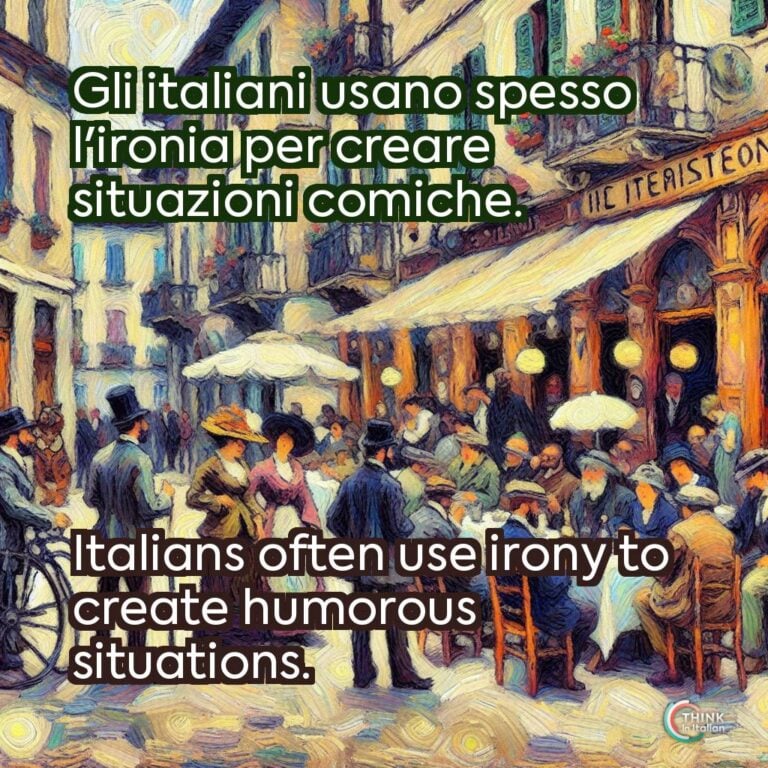Italian Humor: a Cultural Insight
When people think of Italy, they often picture images of Renaissance masterpieces, historic architecture, and mouthwatering cuisine. All this is true, but what you might not know is that another integral aspect of the Italian culture is humor.
Italian humor, shaped by centuries of history, regional diversity, and a collective zest for life, is a blend of irony, exuberance, and a sharp eye for the absurdities that life presents.
What I love of Italian humor is that it is communal: it invites everyone into the joke and fosters shared laughter and bonding. It is not just entertainment, it is an omnipresence part of everyday life.
We really have an innate ability to find humor in the mundane, turning potential frustrations into moments of levity, as if it were a coping mechanism to live a better life.
Understanding the Italian Sense of Humor
Mocking Friends: the art of “Prendere in Giro”
If you are a friend of mine, I am sorry: I will mock you at least once per day. This is what friends do among each other, in a respectful and lovely way.
We call it prendere in giro, which translates to teasing or playful mockery. It is not harsh or mean at all, rather, it is an affectionate way of keeping friends grounded.
It is a way to remind people of their shared humanity, reinforcing bonds of friendship and trust. Mocking friends is an art form, carefully balanced to show camaraderie and affection rather than to cause discomfort.
Self-Irony: Laughing at Oneself
Self-irony is another cornerstone of Italian humor. We do love laughing at ourselves, turning everyday frustrations into jokes. It makes life easier, and it normalizes problems that otherwise would be felt too heavily.
For instance, you might hear a Roman caught in a traffic jam saying:
Dovrei vivere in macchina, così non pago l’affitto.
I should live in my car, so I don’t have to pay rent.
Or my dad’s favorite joke, who has been bald for 20 years now:
Vado a preparami che devo farmi l’acconciatura.
I’m going to get ready because I have to get my hair done.
Such remarks highlight the challenges of daily life while maintaining a light-hearted attitude. Self deprecating humor allows us to navigate life’s problems with a smile, creating an unspoken sense of unity among those who can relate.
Humor in Daily Life
As I mentioned before, Italian humor is deeply rooted in daily interactions, and it often serves as a form of social commentary.
Political satire is very common: comedians and citizens make fun of government inefficiencies and fooleries of public figures. It is commonly seen in social media, as well as in TV programs and movies.
About this, I recommend my favorite Italian comedian, Checco Zalone. He is the best in blending satire with relatable, everyday humor. He intelligently pokes fun at societal norms, politics, and cultural stereotypes in a way that is both hilarious and thought-provoking.
This type of humor is more than entertainment, it’s a cathartic way for Italians to share frustrations and remain positive. It allows for shared laughs that foster a sense of belonging and solidarity, a reminder that everyone is in it together.
Wordplays: the Linguistic Twist
Wordplays are definitely the type of humor that makes me laugh the most. The Italian language, with its rich vocabulary and fluidity, lends itself well to puns and clever twists.
Anything can become fun with the right timing: a friend that uttered a word in a fun way, or someone’s name that resembles something else.
One of my best friend’s name is Raffaele, but we all call him Lele. His favorite type of music? L’elettronica (electronic music). It’s a silly way to play with his name but I will never not laugh at it.
Examples of Italian Humor
Humor in TV: Comedy on Screen
Italian humor is commonly seen in TV shows and movies, bringing laughter to viewers in different ways. Italian classic comedies feature Totò, one of Italy’s most loved comedians. He uses funny situations and wordplay to create jokes that never get old.
Modern shows like Camera Café bring office humor to life with stories that reflect real work situations and make fun of everyday habits.
Italian movies also show how humor can mix with deeper emotions. Roberto Benigni’s “La vita è bella” is a great example of how we use humor to face even the hardest times.
In this film, humor becomes a way to stay strong and show the power of the human spirit, even when things are tough. This shows how Italians believe in using laughter as a way to fight against life’s difficulties.
Best Italian Jokes: From Everyday Quips to Timeless Gags
Italian jokes often come from relatable experiences and the collective imagination. Here are a couple of examples that capture the essence of Italian humor.
The main character is often Pierino, a mischievous and lively young boy known for his pranks and for putting adults in tricky situations with his cleverness.
Jokes about Pierino have become a staple of Italian popular culture, providing a humorous look at everyday interactions between children and adults.
La maestra interroga Pierino:
“Pierino, dimmi due pronomi!”.
“Chi? Io?”
“Bravissimo Pierino! Ora sentiamo un altro”
The teacher asks Pierino:
“Pierino, tell me two pronouns!”
“Who? Me?”
“Well done, Pierino! Now let’s hear someone else”
Laugh in Italian
To truly understand the Italian sense of humor, it’s important to appreciate its deep roots in culture, language, and everyday life. Italian humor is warm, expressive, and often marked by affectionate teasing, clever wordplay, and self-irony.
It reflects our shared resilience and an ability to find joy in life’s ups and downs: it is our way to both cope and celebrate life. Immerse yourself in conversations, media, and cultural nuances, to start grasping the communal nature of Italian humor.
Laughter is not just for amusement but a way of living.






